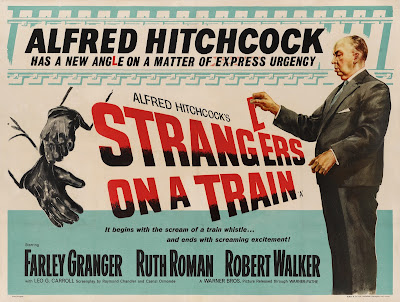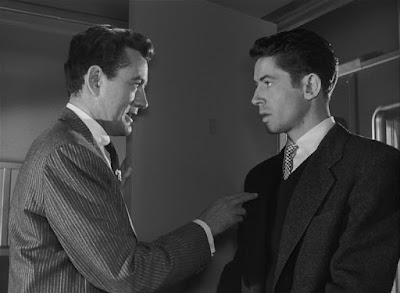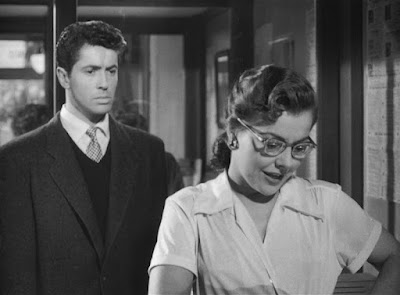(1951) Directed by Alfred Hitchcock; Screenplay by Raymond Chandler and Czenzi Ormonde; Based on the novel by Patricia Highsmith; Starring: Farley Granger, Ruth Roman, Robert Walker, Leo G. Carroll, Patricia Hitchcock and Kasey Rogers; Available on Blu-ray and DVD
Rating: ****
Thanks to Rebecca Deniston from Taking Up Room for hosting the Distraction Blogathon, a celebration of cinematic sleight of hand. Keeping this in mind, I thought it
was an appropriate occasion to shine the spotlight on a title by the Master of
Misdirection himself, Alfred Hitchcock.
“There was a thing in Strangers on a Train that I would never do again. I had an old man – an old actor – crawl underneath the real merry-go-round to switch it off. If his head had gone up an inch or two, I would have been in jail. It would have been manslaughter. And I sweat when I even think about it… at the time.” – Alfred Hitchcock (excerpted from 1974 interview by Andy Warhol, compiled in Alfred Hitchcock Interviews, edited by Sidney Gottlieb)
Strangers on a Train begins with an intriguing, deceptively simple premise – a chance encounter between two men that ends up in murder. Bruno Antony (Robert Walker) approaches tennis ace Guy Haines (Farley Granger)* with a modest proposal. Based on his research about Haines, he deduces each would like someone in their respective lives out of the way (in this case, Guy’s two-timing wife Miriam and Bruno’s overcritical father). Bruno’s elegant solution: they would trade murders, effectively eliminating the respective motive for both men. Guy takes it as a morbid joke, but doesn’t consider this a serious offer, and leave it at that. Bruno, on the other hand, views Guy’s humoring his idea as a tacit agreement, and proceeds with his twisted plan.
* Fun Fact #1: In Patricia Highsmith’s novel, Guy was an
architect.
Guy is stuck in a tight bind. His aspirations go beyond becoming a professional tennis player, and going into politics He’s in love with Senator Morton’s daughter Anne (Ruth Roman), while his estranged wife Miriam* is pregnant with someone else’s baby. After Miriam changes her mind about their impending divorce, a visible argument ensues in the record store where she works. Guy is racked with guilt after he learns that Bruno’s offer was more than idle speculation, and his wife has been murdered. Now, his future plans are in jeopardy, as he’s become the primary suspect. Farley Granger does a credible job, playing someone with a conflicted conscience – simultaneously relieved and horrified that Miriam is gone. Hitchcock is careful to portray Guy as not quite the innocent man he appears to be. When he brings a gun to the Antony residence, there’s a moment when he hesitates, as if he considers going ahead with Bruno’s twisted plan,** perhaps if only so he can return to his own life.
* Fun Fact #2: The thick glasses worn by Kasey Rogers (who appeared under the pseudonym Laura Elliot) as Miriam prevented her from seeing anything on the set, so she was reduced to feeling her way around.
** Fun Fact #3: In Highsmith’s novel, Guy went ahead with
murdering Bruno’s father, which, of course, would have changed the film
considerably.
Without a doubt, all eyes are on Bruno, as expertly played
by Robert Walker (in what sadly proved to be his penultimate film). He’s an
oddly charming sociopath, easier to like than his counterpart (compared to Guy,
who’s a bit aloof). Considering how much he knew about Guy prior to their first
encounter, it’s clear that their “chance” meeting was a calculated move. Walker
plays the scene as if he’s simply a big fan of Guy, and their murder pact is an
agreement between friends. Bruno enjoys having an audience, as he attempts to
ingratiate himself to the Morton family in a later scene. With the relative ease
that he works his way into social situations, you get the feeling he can convince
someone to do just about anything. He continues his amiable appearance, even
when he coldly stalks Miriam at an amusement park,* waiting for the perfect
moment to strike. The more we learn about Bruno, the further we uncover the depths
of his profound mental illness. He exhibits a classic Oedipal relationship with
his parents, as exemplified by his close (some might say enmeshed) relationship
with his overbearing mother, while wanting to kill his father. He’s prone to
flights of fancy cavalierly referring to his plot to blow up the White House as
merely a joke (But considering what we know about Bruno, it might not have been
completely in jest). When he crashes Senator Morton’s (Leo G. Carroll) party, he
speaks with the senator about his idea for a new power source. There are
moments, however, when Bruno’s controlled façade crumbles, and his true nature
emerges. He has a momentary lapse of composure, bristling at Guy when he calls
him “crazy.” In a later scene, Bruno loses control at the senator’s party, while
demonstrating his strangulation technique to an elderly woman.
* Fun Fact #4: If you’re wondering which amusement park Hitchcock chose for the film, you might be disappointed (or not) to learn that it was created specifically for the film, on a ranch in Chatsworth, California (my old stomping grounds), owned by Rowland V. Lee.
Patricia Hitchcock* is a delight as Anne’s true crime-obsessed little sister, Barbara, who’s the icing on the cake for the film’s darkly comic moments. When the Morton family discusses Miriam’s murder, she gleefully points out Guy’s motive for the murder. At the same time, she plays the role of the supportive future sister-in-law, providing a foil for the police detectives who are tailing Guy. Strangers on a Train is peppered with other comic touches, tempering the moments of suspense, as when Bruno pops a little boy’s balloon with his cigarette. In the tense, climactic fight between Bruno and Guy on a whirling, out-of-control carousel, a kid joins in on the fisticuffs.
* Fun Fact #5: According to Patricia Hitchcock, she was
afraid of heights, and protested when her father wanted her to ride the amusement
park’s Ferris wheel. When he asked her how much money it would take, she requested
$100. After the director agreed, she reluctantly went ahead with boarding the
ride, but claimed she was never paid for her troubles.
Hitchcock loves ratcheting up the tension, including visual cues at every turn. Bruno’s hands are featured in multiple shots, foreshadowing Miriam’s murder. In one of the most memorable images, the murder is shown, reflected on Miriam’s glasses. Even something as benign as a tennis match takes on sinister overtones. In one beautifully shot scene, Guy glances across the court, only to see Bruno sitting in the stands. While everyone’s heads turn back and forth, following the ball, Bruno’s eyes remain fixed on Guy. The film maintains the disturbing notion that wherever Guy goes, he’s never alone. As he rides through the streets of Washington, D.C., he finds Bruno standing alone on the steps of the Jefferson Memorial – a constant reminder of the crime that was committed, and his implied obligation. Another repeated image is the film’s MacGuffin, Guy’s lighter* inscribed “A to G” (Anne to Guy), which Bruno intends to plant at the scene of the crime.
* Fun Fact #6: Besides being a MacGuffin, the lighter also
served as product placement for Ronson lighters.
An innocent man, implicated in something far beyond his control is a common Hitchcock theme, explored to the hilt in Strangers on a Train. Many elements of the film, especially the charismatic sociopath (think Hannibal Lecter) have appeared in many subsequent movies and television shows over the years (an especially notable example is director/star Danny DeVito’s underrated 1987 Hitchcock parody, Throw Momma from the Train). If you’ve never seen a Hitchcock movie (If so, why not?), Strangers on a Train is an excellent introduction to the director’s modus operandi. If you’re already a fan, you probably know this is a stellar example of a filmmaker at the top of his craft.
Sources for this article: Alfred Hitchcock Interviews,
edited by Sidney Gottlieb; Warner Brothers Blu-ray commentary; “13 Unfamiliar
Facts About Strangers on a Train,” by Eric D. Snider, Mental Floss








Very enjoyable article. I grow more fond of Strangers on a Train with each viewing, and I have lost count of those viewings.
ReplyDeleteThank you! :) It really does hold up with repeat viewings.
DeleteI think it's Hitch's most successful movie in the sense that everything works just as it should. I'm on a Hitchcock re-watch binge at the moment and STRANGERS ON A TRAIN is definitely going to be included.
ReplyDeleteIt's a movie that lends itself to re-watching (as are many of Hitchcock's films). Thanks for stopping by!
DeleteGreat review of a great Hitchcock film, Barry, and I’m glad you mentioned Throw Momma From The Train!
ReplyDeleteThanks, John! I had fun writing about this one. And Throw Momma from the Train deserves more love! :)
DeleteTotally agree. It's a great underrated film and adored deVitos bromance with Crystal.
DeleteLOL! It gets quoted a lot around our house. :)
DeleteGreat post, Barry! This movie is perfect for the blogathon, and wow, Kasey Rogers must have had such a headache during filming. Ouch. Thanks again for joining. :-)
ReplyDeleteThanks, Rebecca! :) And thanks for hosting such a cool blogathon. I had fun writing about this one.
DeleteAmazingly and appallingly enough, I'm familiar with the basic story, but I've never actually seen Strangers on a Train. I have no real excuse. It is just one of those movies that has fallen through the cracks over the years. Ironically I did see Throw Momma from the Train in the theatre back in high school. It was several years before I even learned it was a parody of Hitchcock's film.
ReplyDeleteNo shame there. There are many, many classics I still haven't seen. I hope you get to see this one eventually. When you do, let me know what you think!
Delete